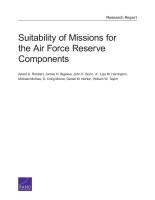| 来源类型 | Research Reports
|
| 规范类型 | 报告
|
| ISBN | 9780833082152
|
| 来源ID | RR-429-AF
|
| Suitability of Missions for the Air Force Reserve Components |
| Albert A. Robbert; James H. Bigelow; John E. Boon; Jr.; Lisa M. Harrington; Michael McGee; Craig Moore; Daniel M. Norton; Bill Taylor
|
| 发表日期 | 2014
|
| 出版年 | 2014
|
| 页码 | 150
|
| 语种 | 英语
|
| 结论 |
Three Main Criteria for Evaluating the Suitability of Missions for Assignment to the Reserve Components (RC)- Surge demand: Force structure is suitably placed in the RC only if there is an anticipated wartime or other episodic surge in demand for forces.
- Duration of activations: Missions with shorter activation periods are more suitable for assignment to the RC.
- Continuation training requirements: Missions with a pronounced continuation training requirement are more suitable for assignment to the RC.
Additional Considerations - Missions with high levels of stress-related deployment or high home-station operational tempo are less suitable for assignment to the RC.
- The readiness of flying units depends on careful management of pilot experience levels.
- To sustain a sufficiently experienced workforce, the RC relies heavily on affiliation of individuals separating from the active component (AC). As the ratio of AC to RC strenghts in a mission drops, the mission becomes less suitable for assignment to the RC.
- The absorption of new pilots into operational units must be limited so as not to adversely impact readiness but sufficient to sustain both AC and RC pilot inventories at acceptable levels.
- Missions with higher proportions of overseas basing are less suitable for assignment to the RC.
- Some missions can be enhanced by engaging reservists in military duties that match or complement special competencies carried over from their civilian occupations.
- Missions that are relevant to the needs of the states are more suitable for assignment to the Air National Guard.
|
| 摘要 |
- Avoid assignment of the remotely piloted aircraft launch and recovery element mission to the reserve components (RC), and evaluate whether assignment of space and cyber missions to the RC is cost-effective.
- Change the programming and management of Military Personnel Appropriation man-days to include consideration of costs and outputs.
- Seek legislative changes to remove the constraints on the use of technicians, active guardsmen and reservists, and Reserve Personnel Appropriation--funded part-time reservists for duties other than training or administration of reserve forces.
- Adopt more widespread use of cost assessments that consider costs and measured outputs, as well as wider dissemination of cost evaluation results, so that all stakeholders gain a better understanding of how costs for various outputs differ between active and reserve units and how these cost-per-output differences affect the overall costs of various force mixes.
- Review and revise organizational constructs (i.e., classic associations vs. individual mobilization augmentee constructs vs. separate active and reserve squadrons) to improve cost-effectiveness.
|
| 主题 | Military Force Planning
; Military Reserves
; United States Air Force
|
| URL | https://www.rand.org/pubs/research_reports/RR429.html
|
| 来源智库 | RAND Corporation (United States)
|
| 资源类型 | 智库出版物
|
| 条目标识符 | http://119.78.100.153/handle/2XGU8XDN/107834
|
推荐引用方式
GB/T 7714 |
Albert A. Robbert,James H. Bigelow,John E. Boon,et al. Suitability of Missions for the Air Force Reserve Components. 2014.
|
|
文件名:
|
x1495316369496.jpg
|
|
格式:
|
JPEG
|

|
文件名:
|
RAND_RR429.pdf
|
|
格式:
|
Adobe PDF
|
除非特别说明,本系统中所有内容都受版权保护,并保留所有权利。